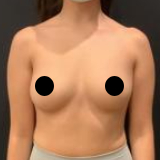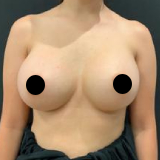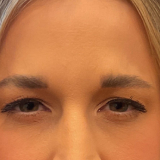Breast Lift with Augmentation
Consultations offered at our three convenient locations in Austin, TX, San Antonio, TX and Westlake Hills, TX

A breast lift with augmentation, or augmentation mastopexy, is a procedure that lifts the breasts and increases their size for a firmer, more youthful look. This comprehensive approach allows patients to achieve their desired breast appearance by addressing concerns such as sagging breasts (ptosis), loss of volume, and asymmetry.
Many women experience issues with the shape and position of their breasts. If your breasts are drooping after weight loss, aging or pregnancy, a breast lift with augmentation can restore their youthful appearance and contour your figure for your desired look.
The team at Austin Plastic Surgeon has transformed patients’ bodies with breast enhancement procedures, helping women meet their body goals. You do not need to wait to restore your curvy figure after aging or pregnancy and there is no need to live with sagging breasts. Contact our office to learn more about how a breast augmentation with a lift can help you achieve the figure you have always wanted.
Contents
- 1 About Augmentation with Lift
- 2 Breast Implants
- 3 Benefits
- 4 Candidates
- 5 Personal Consultation
- 6 Preparation
- 7 Breast Lift with Augmentation Procedure
- 7.1 1. Anesthesia
- 7.2 2. Incision Patterns
- 7.3 3. Breast Lift (Mastopexy)
- 7.4 1. Superior Pedicle Technique
- 7.5 2. Inferior Pedicle Technique
- 7.6 3. Medial Pedicle Technique
- 7.7 4. Lateral Pedicle Technique
- 7.8 5. Superior-Medial Pedicle Technique
- 7.9 6. Central Pedicle Technique
- 7.10 4. Implant Insertion
- 7.11 5. Combining the Procedures
- 7.12 6. Closing the Incisions
- 7.13 7. Post-Surgical Dressings and Support
- 8 Recovery
- 9 Results
- 10 Complementary Procedures
- 10.1 Internal Bra for Breast Support: Enhancing Mastopexy and Augmentation Results
- 10.2 What is an internal bra?
- 10.3 Capsulorrhaphy in Breast Implant Placement: Enhancing Breast Augmentation Outcomes
- 10.4 What is Capsulorrhaphy?
- 10.5 Indications for Capsulorrhaphy
- 10.6 Capsulorrhaphy Techniques
- 10.7 1. Capsular Plication
- 10.8 2. Capsular Flaps
- 10.9 3. Internal Bra Technique
- 10.10 4. Capsular Excision
- 10.11 Benefits of Capsulorrhaphy
- 10.12 Fat Transfer to the Breast with Mastopexy: A Comprehensive Guide
- 10.13 What is Fat Transfer to the Breast?
- 10.14 Combining Fat Transfer with Mastopexy
- 10.15 Benefits of Combining Fat Transfer with Mastopexy
- 10.16 Considerations and Risks
- 10.17 Tummy Tuck
- 10.18 Mommy Makeover
- 10.19 Buttock Augmentation
- 11 Cost of Breast Augmentation with Lift in Austin
- 12 FAQ
- 13 References
About Augmentation with Lift
Breast lift with augmentation is a popular procedure for improving the volume and position of the breasts to help you feel more comfortable in your body. The breast lift (mastopexy) aspect will remove excess skin for smoother, younger-looking breasts. The augmentation will increase the volume of your breasts with implants and/or fat transfer to help you achieve the silhouette you desire.
Augmentation mastopexy is considered a complex and challenging procedure. (1) Here are some reasons why:
- Dual Goals: The procedure aims to both increase breast volume and while removing excess skin to lift and tighten the breasts. Balancing these dual objectives requires precision and expertise.
- Tissue Manipulation: It involves significant manipulation of breast tissues, including skin, fat, and glandular tissue. This requires careful planning to achieve the desired shape and symmetry.
- Implant Placement: Choosing the right size and type of implant, as well as determining the optimal placement (above or below the muscle), adds another layer of complexity.
- Fat Transfer – Fat transfer has continued to gain popularity as some patients want to avoid the use of a breast implant, but still want to increase the volume in their breasts. New technology such as Viality has improved the precision processing of fat which has made fat transfer much more reliable and predictable for breast enhancement.
- Skin Tightening: Removing excess skin and tightening the remaining skin to achieve a youthful contour while ensuring proper healing and minimal scarring is a delicate process.
The procedure has helped thousands of patients achieve outstanding results, and you can too. The team at Austin Plastic Surgeon offers several different types of implants to help you meet your goals.
A Solution to “Ozempic Breast”
Aging and pregnancy are not the only reasons you might consider breast lift with augmentation surgery. If you’ve experienced significant weight loss, especially through a medical weight loss program involving semaglutide or tirzepatide, you might encounter new sagging, or so-called “Ozempic breast.” Augmentation with lift surgery offers comprehensive results by elevating the breast mound, helping you fully appreciate your well-earned figure.
Breast Implants
We will choose the type, projection, and size of the implant based on your body proportions and cosmetic desires. There are several different types of implants to help you achieve your desired contour:
We will place the implant behind the muscle (submuscular placement) or in front of the muscle and below the fascia (subfascial placement) depending on your body goals to help you create your desired look. (2)
Benefits
After a breast augmentation with lift, you will have firmer, lifted, younger-looking breasts. The benefits of a breast augmentation with lift include:
- Firmer breasts
- Curvier figure
- Enhanced body proportions
- Increased self-esteem
- Better fitting bras
- Smoother breasts
- Long-lasting results
- Fast recovery time
Candidates
Ideal candidates for breast augmentation with lift are individuals who:
- Are unhappy with the size, shape, and position of their breasts
- Experience sagging or drooping breasts
- Desire increased breast volume and improved breast contour
- Have realistic expectations about the outcomes of the procedure
- Are in good overall health and not currently pregnant or breastfeeding
- Patients that have developed Ozempic Breasts
- Patients that have developed significant changes in their breasts after weight loss, pregnancy or natural aging changes.
Personal Consultation
During your consultation, your Austin Plastic Surgeon will discuss your medical history and current medications to determine if you are a good candidate for the procedure. They will also discuss your body goals to understand your expectations and desired look. The type of implant, incision type, and implant shape will determine your results. We will discuss your options to choose the best implant type and incision. Call your nearest Austin Plastic Surgeon location to schedule:
Preparation
Preparing for your breast augmentation with a lift procedure is essential to ensure optimal results and a smooth recovery. Your instructions may include:
- Discontinuing certain medications or supplements that can increase the risk of bleeding
- Undergoing a preoperative medical evaluation to ensure you are in good health for surgery
- Quitting smoking and avoiding nicotine products to promote proper healing
- Arranging for a responsible adult to accompany you on the day of surgery and drive you home afterward
- Planning for time off work or other responsibilities to allow for a comfortable and stress-free recovery period
Breast Lift with Augmentation Procedure
Mastopexy augmentation is a sophisticated procedure that requires a high level of precision and skill. Here is an expanded step-by-step explanation of the surgical process:
1. Anesthesia
The procedure begins with the administration of anesthesia. This ensures that the patient is comfortable and pain-free throughout the surgery. The most common types of anesthesia used are general anesthesia, which puts the patient to sleep, or intravenous sedation combined with local anesthesia.
2. Incision Patterns
The choice of incision pattern depends on the degree of breast sagging (ptosis), the amount of excess skin, and the desired size of the implants. The main incision techniques include:
- Periareolar Incision: An incision made around the circumference of the areola. This is suitable for women with mild ptosis and minimal excess skin.
- Vertical Incision: Extends from the bottom of the areola to the breast crease, often referred to as a “lollipop” incision. This is effective for moderate ptosis and provides greater lift.
- Inverted T Incision: Also known as an “anchor” incision, it includes a periareolar incision, a vertical incision, and a horizontal incision along the breast crease. This technique is ideal for significant sagging and offers the most comprehensive lift.
3. Breast Lift (Mastopexy)
After making the incisions, the surgeon lifts and reshapes the underlying breast tissue to improve breast contour and firmness. The nipple and areola are repositioned to a more youthful height, and if necessary, the size of the areola can be reduced by excising skin around its perimeter.
In breast lift surgeries, the term “pedicle” refers to the stalk of tissue that includes blood vessels, nerves, and ducts, which supplies the nipple-areolar complex (NAC) with necessary blood flow and sensation. Different pedicle techniques are used to maintain the vitality of the NAC while repositioning it higher on the breast. Here are the main types of breast lifts based on pedicle techniques:
1. Superior Pedicle Technique
- Description: In the superior pedicle technique, the tissue that supports the NAC comes from the upper part of the breast.
- Best for: Moderate ptosis and patients who need a moderate lift.
- Scarring: Typically involves a periareolar incision and may include a vertical incision.
- Benefits: This technique maintains good blood supply to the NAC and is effective for achieving a natural breast shape.
2. Inferior Pedicle Technique
- Description: The inferior pedicle technique uses tissue from the lower part of the breast to support the NAC.
- Best for: Significant ptosis and larger breast lifts.
- Scarring: Often involves an inverted T or anchor incision pattern.
- Benefits: Provides strong support for the NAC, suitable for substantial lifts, and allows for significant reshaping and volume reduction if needed.
3. Medial Pedicle Technique
- Description: The medial pedicle technique uses tissue from the inner (medial) part of the breast to support the NAC.
- Best for: Moderate ptosis and patients who want a more rounded breast shape with fullness in the inner aspect.
- Scarring: Typically includes a vertical and periareolar incision, and sometimes a horizontal incision in the breast crease.
- Benefits: Helps achieve medial fullness and a more natural-looking cleavage, maintains good blood flow to the NAC.
4. Lateral Pedicle Technique
- Description: The lateral pedicle technique uses tissue from the outer (lateral) part of the breast to support the NAC.
- Best for: Specific cases where lateral breast tissue needs to be repositioned or reduced.
- Scarring: Scarring patterns vary, but often involve periareolar and vertical incisions.
- Benefits: Can be used to correct asymmetries and improve the outer contour of the breast.
5. Superior-Medial Pedicle Technique
- Description: A combination of superior and medial pedicle techniques, supporting the NAC from the upper and inner parts of the breast.
- Best for: Moderate to significant ptosis, especially in patients seeking upper pole fullness and medial cleavage.
- Scarring: Typically involves periareolar, vertical, and sometimes horizontal incisions.
- Benefits: Provides excellent upper pole fullness, natural cleavage, and maintains robust blood supply to the NAC.
6. Central Pedicle Technique
- Description: In the central pedicle technique, the NAC is supported by tissue from the central part of the breast.
- Best for: Various degrees of ptosis, often used in breast reduction surgeries.
- Scarring: Scarring patterns can include periareolar, vertical, and horizontal incisions.
- Benefits: Ensures central positioning of the NAC with reliable blood supply, effective for reshaping and lifting.
Choosing the Right Pedicle Technique
The choice of pedicle technique in a breast lift depends on several factors, including:
- Degree of Sagging: The severity of ptosis influences which pedicle technique is most suitable.
- Breast Size and Shape: The current and desired breast size and shape play a role in determining the best pedicle approach.
- Nipple-Areola Position: The current position of the NAC and the desired elevation affect the choice of pedicle.
- Surgeon’s Expertise: The surgeon’s experience and comfort with specific techniques can influence the decision.
- Patient’s Goals: The aesthetic goals and preferences of the patient are crucial in selecting the appropriate technique.
Understanding the different pedicle techniques in breast lift surgery helps patients and surgeons collaborate effectively to achieve the desired outcomes. Each technique offers unique benefits and is tailored to specific anatomical and aesthetic needs. Consulting with a board-certified plastic surgeon will help you determine the most suitable pedicle technique for your breast lift, ensuring a safe procedure and beautiful, natural-looking results. If you’re considering a breast lift, contact our clinic to schedule a consultation and explore the options that best meet your individual needs and goals.
4. Implant Insertion
Once the breast lift is complete, the surgeon proceeds with the breast augmentation:
- Implant Selection: The choice between saline and silicone implants depends on the patient’s preference, desired feel, and aesthetic goals. Silicone implants tend to feel more like natural breast tissue, while saline implants are filled with sterile salt water and are adjustable in size during surgery.
- Implant Placement: The implants can be placed in one of two locations:
- Submuscular (under the pectoral muscle): Provides a more natural look, especially in women with less natural breast tissue, and may reduce the risk of certain complications.
- Subglandular (over the pectoral muscle and under the breast gland): This placement allows for a shorter recovery period and may be preferable for women with adequate natural breast tissue.
5. Combining the Procedures

In a mastopexy augmentation, the combination of lifting the breast tissue and inserting implants can be done in one surgery, allowing for a single recovery period and providing comprehensive enhancement of the breast’s appearance.
6. Closing the Incisions
Once the implants are in place and the desired breast shape is achieved, the surgeon carefully closes the incisions with layered sutures in the breast tissue to support the newly shaped breasts. Sutures, skin adhesives, or surgical tape are used to close the skin incisions. The surgeon may place drainage tubes to prevent fluid accumulation, which are typically removed within a few days.
7. Post-Surgical Dressings and Support
After the incisions are closed, the surgeon applies dressings or bandages to the incisions. A support bra or elastic bandage is worn to minimize swelling and support the breasts as they heal. This post-operative garment helps to ensure proper alignment and healing of the breast tissue.
Recovery
After your breast augmentation with lift surgery, it is normal to experience temporary swelling, bruising, and discomfort. will provide comprehensive postoperative instructions to ensure a smooth and comfortable recovery. It is crucial to follow these instructions closely to facilitate proper healing and achieve optimal results. Some common aspects of the recovery process include:
- Wearing a supportive surgical bra to minimize swelling and support the newly enhanced breasts
- Taking prescribed pain medication to manage any discomfort during the initial days after surgery
- Avoiding strenuous activities, heavy lifting, and exercise for several weeks
- Attending scheduled follow-up appointments with Dr. Kiripolsky to monitor your progress and address any potential concerns
Results
You will see the results of your breast lift with augmentation immediately, but you can enjoy the full effects after a few months when the implants have settled. The implants have a natural shape, feel, and look. You will have a curvier contour and can enjoy youthful-looking breasts for years to come.
Complementary Procedures
Internal Bra for Breast Support: Enhancing Mastopexy and Augmentation Results
The internal bra technique is a relatively new innovation in breast surgery designed to provide long-lasting support and enhance the results of breast lifts (mastopexy) and augmentations. This technique involves the use of a supportive mesh or scaffold to create an internal structure that mimics the natural support of a bra, helping to maintain breast shape and position over time. Here’s an in-depth look at the internal bra procedure, its benefits, and considerations.
What is an internal bra?
An internal bra is a surgical technique that incorporates a supportive material, usually a mesh, into the breast tissue to provide additional structural support. This material is typically made from biocompatible substances that are either absorbable or non-absorbable, ensuring safety and compatibility with the body.
Capsulorrhaphy in Breast Implant Placement: Enhancing Breast Augmentation Outcomes
Capsulorrhaphy is a surgical technique used in breast augmentation and revision surgeries to modify the implant pocket and improve the placement and stability of breast implants. This procedure involves tightening or reinforcing the capsule around the implant to correct issues such as implant malposition, asymmetry, or bottoming out. Here’s an in-depth look at capsulorrhaphy, its indications, techniques, benefits, and considerations.
What is Capsulorrhaphy?
Capsulorrhaphy involves suturing the fibrous capsule that naturally forms around a breast implant after surgery. This technique can tighten, reshape, or reinforce the capsule to create a more stable and properly positioned implant pocket
Indications for Capsulorrhaphy
Capsulorrhaphy is typically performed to address various complications or issues related to breast implants, including:
- Implant Malposition
- Lateral Malposition: When the implant shifts too far to the side.
- Medial Malposition: When the implant moves too close to the midline or sternum.
- Superior Malposition: When the implant sits too high on the chest.
- Inferior Malposition (Bottoming Out): When the implant drops too low on the chest.
- Symmastia (Uniboob)
- A condition where the implants move too close together, causing a loss of cleavage and creating a continuous mound of tissue across the chest.
- Capsular Contracture
- A condition where the capsule tightens excessively around the implant, causing discomfort and distorting the breast shape.
- Implant Asymmetry
- When one implant sits higher, lower, or more to the side than the other, causing uneven breast appearance.
- Pocket Over-Dissection
- When the implant pocket is created too large, leading to implant movement and instability.
Capsulorrhaphy Techniques
1. Capsular Plication
- Description: This technique involves folding and suturing the capsule to reduce the size of the implant pocket and provide additional support.
- Procedure: The surgeon makes incisions to access the capsule, then sutures the capsule tissue to create a tighter and more supportive pocket.
2. Capsular Flaps
- Description: The capsule is partially cut and folded over to create flaps that can be sutured to provide support and prevent implant movement.
- Procedure: The surgeon creates flaps from the existing capsule tissue and sutures them to the chest wall or remaining capsule to reinforce the pocket.
3. Internal Bra Technique
- Description: Involves creating a supportive structure within the breast tissue using the patient’s own tissue or synthetic materials to act like an internal bra.
- Procedure: The surgeon uses capsular tissue or supportive mesh to create a hammock-like support for the implant, ensuring proper positioning and stability.
4. Capsular Excision
- Description: In cases of severe capsular contracture or excessive capsule tissue, the surgeon may remove (excise) part of the capsule to release tension and create a more flexible pocket.
- Procedure: The surgeon excises the problematic capsule tissue and may use other techniques like plication or flaps to recreate a stable implant pocket.
Benefits of Capsulorrhaphy
- Improved Implant Positioning: Ensures the implants are properly positioned, creating a more natural and symmetrical breast appearance.
- Enhanced Stability: Provides additional support to prevent future implant movement and complications.
- Correction of Complications: Addresses issues like malposition, asymmetry, and capsular contracture, improving overall outcomes.
- Aesthetic Enhancement: Enhances the overall aesthetic results of breast augmentation, leading to higher patient satisfaction.
Capsulorrhaphy is a valuable technique in breast surgery, providing enhanced support and stability for breast implants. Whether addressing complications from previous surgeries or ensuring optimal implant placement from the outset, capsulorrhaphy can significantly improve aesthetic outcomes and patient satisfaction. If you’re experiencing issues with your breast implants or considering breast augmentation, consult with a board-certified plastic surgeon to explore the benefits of capsulorrhaphy and achieve your desired results. Contact our clinic today to schedule a consultation and take the first step toward beautifully enhanced and supported breasts.
Fat Transfer to the Breast with Mastopexy: A Comprehensive Guide
Combining fat transfer to the breasts with a mastopexy (breast lift) offers a unique approach to achieving natural breast enhancement and rejuvenation. This procedure not only lifts and reshapes the breasts but also uses the patient’s own fat to add volume and improve contour. Here’s an in-depth look at the process, benefits, and considerations of combining fat transfer with mastopexy.
What is Fat Transfer to the Breast?
Fat transfer, also known as fat grafting or lipofilling, involves harvesting fat from one part of the body (such as the abdomen, thighs, or flanks) and injecting it into the breasts to enhance their shape and size. This technique provides a natural alternative to implants, using the patient’s own tissue to achieve the desired augmentation
Combining Fat Transfer with Mastopexy
The Procedure
- Consultation and Planning
- Initial Assessment: During the consultation, the surgeon will evaluate the patient’s breast anatomy, skin quality, and aesthetic goals. This includes discussing the desired lift and volume enhancement.
- Donor Site Identification: The surgeon will identify suitable donor sites for fat harvesting, such as the abdomen, thighs, or flanks.
- Anesthesia
- The procedure is typically performed under general anesthesia to ensure patient comfort.
- Fat Harvesting
- Liposuction: Fat is harvested from the donor sites using liposuction. Small incisions are made, and a cannula is inserted to gently suction out the fat.
- Purification: The harvested fat is then purified through a centrifugation process to separate viable fat cells from blood, oil, and other impurities.
- Mastopexy
- Incision and Lifting: The surgeon makes the necessary incisions for the breast lift. Common incision patterns include periareolar, vertical (lollipop), or anchor (inverted T) incisions.
- Reshaping and Lifting: Excess skin is removed, and the breast tissue is reshaped. The NAC is repositioned to a higher, more youthful position.
- Fat Injection
- Strategic Placement: The purified fat is carefully injected into the breasts using small cannulas. The surgeon strategically places the fat to enhance volume, improve contour, and achieve symmetry.
- Layering Technique: Fat is injected in small amounts and layered to ensure even distribution and natural-looking results.
- Closing the Incisions
- The incisions are closed with sutures, and the breasts are bandaged for support and protection during the initial healing phase.
Benefits of Combining Fat Transfer with Mastopexy
- Natural Enhancement: Fat transfer uses the patient’s own tissue, resulting in a natural look and feel.
- Dual Benefits: The procedure offers both lifting and volume enhancement, addressing sagging and size simultaneously.
- Minimal Scarring: Fat transfer involves small incisions for liposuction and injections, resulting in minimal scarring.
- Customized Results: The surgeon can tailor the procedure to the patient’s specific needs and aesthetic goals.
- Body Contouring: Liposuction of the donor sites provides additional body contouring benefits, enhancing overall body proportions.
Considerations and Risks
- Fat Resorption: Not all transferred fat cells survive; some may be reabsorbed by the body. This can result in a slight reduction in volume over time.
- Multiple Sessions: In some cases, additional fat transfer sessions may be needed to achieve the desired volume.
- Scarring: While minimal, there will be some scarring from the mastopexy incisions.
- Recovery: Recovery involves downtime for both the breast lift and the liposuctioned areas. Patients should plan for a few weeks of reduced activity.
- Breast
- Other areas
Tummy Tuck
A tummy tuck (abdominoplasty) is a body contouring procedure that removes excess skin from the midsection as well as strengthening the abdominal muscle with sutures. This procedure can be a transformative experience for individuals who are looking to restore their post-pregnancy belly, contour their body after significant weight loss, or address issues such as muscle separation and loose skin in the abdominal area.
Mommy Makeover
A mommy makeover refers to a combination of surgical procedures designed to address the aesthetic concerns that arise after pregnancy and childbirth. This is a highly customizable procedure that can include breast enhancement, a tummy tuck, liposuction, and any additional contouring required to transform the body for a smoother, perkier, more shapely look.
Buttock Augmentation
Buttock augmentation is a surgical procedure that involves the use of implants or fat transfer to enhance the appearance of the buttocks. This procedure can address concerns such as flatness, asymmetry, or lack of volume in the buttock area. Whether you are considering buttock implants, a Brazilian Butt Lift (BBL) using fat transfer, or any other buttock augmentation technique, your Austin Plastic Surgeon is dedicated to providing you with personalized care and exceptional results.
Cost of Breast Augmentation with Lift in Austin
The cost of a breast augmentation with lift will depend on the results you are looking to achieve including the type and size of the implant you would like. During your consultation, we can provide an all-inclusive quote. Contact our office or contact one of our locations to learn more about our breast augmentation with lift procedures, and how we can help you meet your body goals:
FAQ
Does breast augmentation with lift require separate surgeries?
Breast augmentation with lift combines both procedures into a single surgical session. This approach allows for improved efficiency and eliminates the need for multiple surgeries.
Can I breastfeed after breast augmentation with lift?
The ability to breastfeed following breast augmentation with lift can vary from patient to patient. Advancements in surgical techniques have significantly reduced the risk of breastfeeding complications, but individual factors and anatomy may still influence milk production and breastfeeding ability.
How long do results from breast augmentation with lift last?
The results of breast augmentation with lift are long-lasting; however, it is important to note that breast tissue and shape can change over time due to factors such as aging, weight fluctuations, and pregnancy. Regular follow-up appointments and a healthy lifestyle can help maintain the longevity of your results.
How can I maintain my results after a breast augmentation with lift?
The best way to maintain your results is to take good care of your body and take care to wear your compression garment during your recovery to ensure your body heals correctly so you can enjoy the results of your implants.
References
- Hubaide M, Ono MT, Karner BM, Martins LV, Pires JA. Safe Augmentation Mastopexy: Review of 500 Consecutive Cases Using a Vertical Approach and Muscular Sling. Plastic and Reconstructive Surgery – Global Open. 2024;12(1):e5504-e5504. doi:https://doi.org/10.1097/gox.0000000000005504
- Pelc Z, Skórzewska M, Kurylcio A, et al. Current Challenges in Breast Implantation. Medicina. 2021;57(11):1214. doi:https://doi.org/10.3390/medicina57111214





